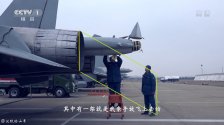China's WS-15 turbofan engine undergoes tests, shows improved performance
The WS-15, China's next generation turbofan engine expected to be used on the J-20 stealth fighter jet to greatly improve its performance, has undergone several tests that saw the engine further improved and optimized, the state broadcaster recently reported.
After the large scale equipment of the WS-10, China's first independently developed high performance, high thrust turbofan engine with afterburner, on Chinese fighter jets including the J-10, the J-11 and the J-20 since 2016, the country's next generation turbofan engine, the WS-15, has undergone several tests, China Central Television (CCTV) reported on Sunday.
Developed for fifth-generation heavy and medium fighter jets, the WS-15 has a low bypass ratio and is capable of thrust vector control, CCTV said.
With the tests, all parameters of the WS-15 have been further improved and optimized, the CCTV reported, noting that the more powerful WS-15 is expected to replace the WS-10 for the J-20 in the future, so the J-20 will finally become its ultimate form.
A distinguishing characteristic of a next generation high thrust engine for combat aircraft is that it should have a thrust of between 15 to 18 tons, military expert Wang Mingliang said on CCTV.
When the J-20 gets the new engines, it will become a more powerful platform, thanks to boosted super-cruise capability and super-maneuverability, in addition to its already excellent stealth capability and situational awareness, the expert said.
China has already displayed a thrust vector control-capable engine in flight by a J-10 fighter jet at Airshow China 2018. So such technology will not be a problem for China, and the increase in the thrust-to-weight ratio and the reduction in fuel consumption has always been a goal in engine development, Wang Ya'nan, chief editor of Aerospace Knowledge magazine, told the Global Times.
The technology gap between China and leading countries like the US in terms of jet engine development had been significantly narrowed in recent years, said Wang Ya'nan.
The reason behind this surge is China's accumulation of technologies and theories over the past decade, the establishment of the Aero Engine Corporation of China, and the breakthrough in key materials like those for single crystal blades, said Wang Mingliang.
Besides the WS-15, the WS-20, China's next generation turbofan engine with a high bypass ratio, is believed to be undergoing tests on the Y-20 large transport aircraft, CCTV reported, citing a photo recently circulating on the internet.
China has been testing two new types of domestically developed engines for the Y-20, the aircraft's chief designer Tang Changhong said at the Airshow China 2021.
In addition to larger engines for fighter jets and transport planes, China is also developing smaller engines, which is a very practical move as such engines would support smaller aircraft such as drones and cruise missiles, said Wang Mingliang.




